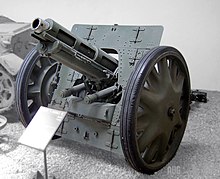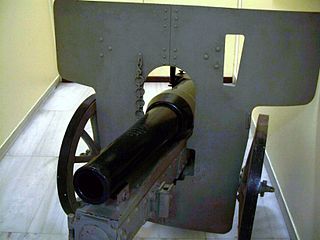
Mountain guns are artillery pieces designed for use in mountain warfare and areas where usual wheeled transport is not possible. They are generally capable of being taken apart to make smaller loads for transport by horses, humans, mules, tractors, or trucks. As such, they are sometimes called "pack guns" or "pack howitzers". During the American Civil War these small portable guns were widely used and were called "mountain howitzers".

The Cannone da 75/27 modello 11 was a French-designed field gun produced in Italy prior to World War I. It was introduced in 1912, designed by Joseph-Albert Deport. It was taken into service by Italy for use with its Alpine and cavalry troops going into World War I, and was built there in large numbers. The gun was designed with two notable features. It was the first artillery piece to introduce the split trail, as well as the last to utilize its novel dual-recoil system. The former became a very popular feature on artillery pieces through to the modern day. The later, while functional, did not get repeated. The dual-recoil system consisted of a small tubular recoil under the barrel which in turn traveled in a traditional rectangular cradle. This lessened heat transfer from the gun barrel to the recoil mechanism effectively, but was not necessary for the added complexity.

The Obice da 210/22 modello 35 was an Italian heavy howitzer designed by the Italian Arms and Munitions Technical Service (STAM) and accepted into service by the Italian Army in 1938. A total of 346 were ordered and the gun was produced by Ansaldo at their Pozzuoli factory. However production was slow and approximately 85 were produced by September 1943. After Italy surrendered Germany seized as many as they could and a factory in Northern Italy continued to produce a small number for the German Army. The carriage was split trail with four wheels which raised from the ground for firing and the gun was trunnioned under the breech to allow for maximum recoil and elevation.
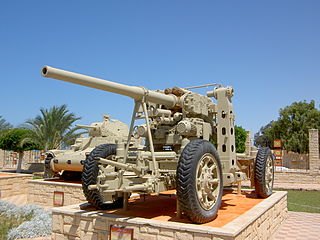
The Cannone da 90/53 was an Italian-designed cannon used both in an anti-aircraft role and as an anti-tank gun during World War II. It was one of the most successful anti-aircraft guns to see service during the conflict. The naval version of the gun was mounted on Italian battleships of the Littorio-class and the Andrea Doria-class.
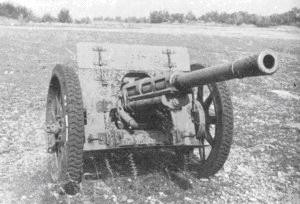
The Cannone da 75/32 modello 37 was an Italian field gun used during World War II. The designation indicates that the gun had a 75 mm caliber, the barrel was 32 caliber-lengths long and it was accepted for service in 1937.

The Ansaldo 105/25 M43, also known as Semovente 105/25, was an Italian self-propelled gun used during World War II and designed by Ansaldo. It was the most powerful self-propelled gun built by Italy in numbers during World War II.

The Canon de 155 C modèle 1917 Schneider, often abbreviated as the C17S, was a French howitzer designed by Schneider. It was essentially the Canon de 155 C modèle 1915 Schneider fitted with a different breech to use bagged propellant rather than the cartridge cases used by the older howitzer. It was used by France, Russian Empire, Belgium, Romania, and the United States from 1917 during World War I and was widely exported after the war. Surviving weapons were in service with France, Poland, Greece, Italy, Belgium, the United States, and Finland during World War II. Captured weapons were used by the Germans for their 2nd-line artillery and coast defense units.

The Semovente da 149/40 was an Italian self-propelled artillery piece designed in 1942. Only a single unit was built; this vehicle is displayed at the US Army Ordnance Museum, Aberdeen, Maryland.

The 10 cm M. 14 Feldhaubitze was a dual-purpose field and mountain gun used by Austria-Hungary during World War I. Between the wars it was used by Austria, Italy, and Poland. During World War II it served as the standard medium howitzer of the Royal Italian Army with the designation Obice da 100/17 modello 14 and after 1943 captured weapons were used by Nazi Germany's Wehrmacht under the designations 10 cm leFH 14(ö) and 10 cm leFH 315(i). After World War II an updated howitzer remained in service with the Italian Army until 1975.

The Mortaio da 210/8 was a siege howitzer which served with Italy during World War I and World War II.

The Obice da 105/14 modello 18 was a howitzer used by Italy during World War II. The howitzer was designed by Schneider in 1906. It was chosen by the Italian Regio Esercito to serve as their new field gun, but licence production by Ansaldo was slow. Some more were produced during the interwar years, but the captured Austrian Obice da 100/17 was generally considered to be superior.

The Semovente da 75/18 was an Italian self-propelled gun of the Second World War. It was built by mounting the 75 mm Obice da 75/18 modello 34 mountain gun on the chassis of a M13/40, M14/41 or M15/42 tank. The first 60 were built using the M13/40 chassis and a subsequent 162 were built on the M14/41 chassis from 1941 to 1943. A total of 190 were built utilizing the M42 chassis before the armistice and an additional 55 were built afterwards. The Semovente da 75/18 was intended to be an interim vehicle until the heavier P40 tank could be available.

Obice da 305/17 was an Italian howitzer used during World War I. Produced by the Armstrong works in Italy between 1914 and 1917, approximately 30-44 were built. Originally the Obice da 305/17 Modello 15 was a stationary coastal defense gun but was later adapted to a mobile siege artillery role. A number also served during World War II.

Tanks have been employed by the military forces in Italy since their first use in World War I. They have had continued use in wars after and are still used through the modern day. The C1 Ariete is the current main battle tank of the Italian Army.

The Obice da 149/12 was an Italian howitzer produced under license in Italy by Ansaldo and Vickers-Terni which was used during World War I and World War II.

The Obice da 280 was an Italian coastal defense and siege howitzer designed in 1884 by the British Armstrong firm and produced under license by the Ansaldo company during the late 1800s. It was used during both the First and Second World Wars.
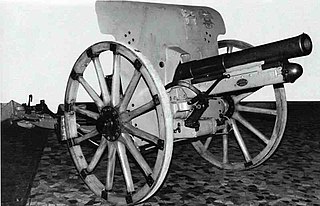
The Cannone da 75/27 modello 1912 cannon was a piece of horse artillery used by the Royal Italian Army during the First and Second World Wars. The Germans designated captured guns as the 7.5 cm Feldkanone 245(i).

The Mortaio da 210/9 modello 1914 was an Italian Heavy Mortar designed by the French Schneider Company and produced under license in Italy by Ansaldo for the Italian Army and used during the First World War.

